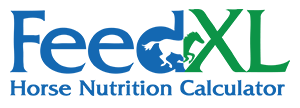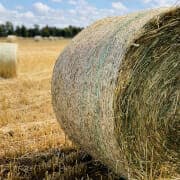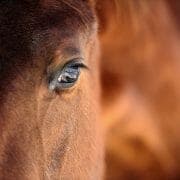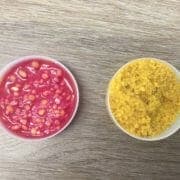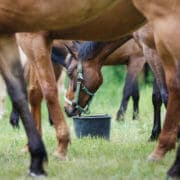Complete Feeds vs Balancer Pellets vs Supplements: Choosing a Feeding Method
Complete Feeds, Concentrates/Balancer Pellets and Supplements—Choosing how to feed
While there are many commercial feed and supplement options available, they can be classified into 3 broad categories; complete feeds, concentrates/balancer pellets and supplements. Depending on your own personal preferences you can use one or a combination of these options to put together a diet for your horse.
This article will help you make choose the best feed option for your horse by taking a look at what the 3 options are, how they should be used and the advantages and disadvantages of each one.
Complete Feeds
A complete feed is a feed that has been formulated to meet the energy, protein, vitamin and mineral requirements of horses. They can be in the form of pellets, cubes, meal or sweetfeeds. Each complete feed will be formulated specifically for a certain type of horse. For example there are complete feeds for breeding horses, horses in sales preparation, pleasure horses, horses in hard work, horses that tie‐up … the list can go on and on.
Complete feeds will contain a variety of ingredients which are usually some combination of grains and grain byproduct (wheat, barley, corn, oats, bran, pollard), legumes or oilseeds (soybean, faba bean, lupins and other protein meals like cottonseed), minerals like salt, limestone and dicalcium phosphate as well as a trace‐mineral and vitamin premix. Many also contain oil.
For a complete feed to actually be “complete” when you use it in your horse’s diet, you must follow the manufacturer’s feeding recommendations for the feed. For example, a working horse feed will have a table on the bag that will say something like for a 500 kg horse in moderate work, you should feed 3 – 4 kg/day. If you feed less than this amount, your horse’s diet will not contain the required levels of vitamins and minerals and the feed will no longer be complete.
A common problem people find with complete feeds is that these feeding rates are too high, with many owners exclaiming their horse would explode if it was fed that much. If this is the case, the complete feed may need to be “topped up” with an appropriate supplement. Using this approach allows you to control your horse’s calorie intake, without compromising vitamin and mineral intakes. Alternatively, if the feeding rates of complete feeds are always too high for your horse, consider using either a concentrate/balancer pellet or supplement.
Complete feeds also don’t allow much flexibility in a feeding program, because deviating from the recommended feeding rates will mean you also unbalance your horse’s diet, so horses needing constant adjustment of their diet according to daily workload, bodyweight and temperament aren’t well suited to a complete feed.
Keep in mind that not all “complete feeds” are created equally. Some will do a very good job of meeting requirements when fed at the correct rates, while others will still leave many deficiencies in your horse’s diet, even when being fed at the recommended levels. This is where FeedXL is a big help—it allows you to easily see which complete feeds really are complete and which aren’t.
A diet for a working horse using a complete feed might look like this:
3.5 kg/day of complete feed
Plus chaff, hay and/or pasture
Concentrates and Balancer Pellets
Concentrates and balancer pellets are fed to meet a horse’s vitamins and mineral requirements, but unlike complete feeds, they only meet part of a horse’s energy and protein requirement. They can be in the form of pellets or sweetfeeds and have a feeding rate of between 0.5 kg and 2.5 kg/day. Concentrates and Balancer Pellets are designed to be fed in conjunction with other protein and energy sources like grains, legumes and oilseeds. They can also be fed alone when the horse has access to good quality pasture or is an easy keeper that doesn’t need the additional calories or protein.
The major advantage of a concentrate or balancer pellet over a complete feed is that it allows you more flexibility within your feeding program. Once you find the required rate of concentrate or pellet your horse needs to meet vitamin and mineral requirements you can then customise the rest of the diet to suit your horse’s tastes and your budget. They also allow you to adjust the amount of calories or protein you feed according to your horse’s workload, weight or temperament without affecting vitamin and mineral intake.
A diet for a working horse using a concentrate or balancer pellet might look like this:
1 kg/day of Balancer Pellet
0.5 kg/day Lupins
2 kg/day Oats
Plus chaff, hay and/or pasture
The minor disadvantage of feeding in this manner is the time it takes to mix the feed.
Supplements
Supplements are designed to be fed with grains, legumes and oilseeds, when needed, to make up a complete diet for horses. They may also be fed alone (mixed with a small amount of chaff or some other tasty base so the horses will eat them) to easy keepers when only vitamins and minerals need adding to the diet.
Supplements are also commonly fed with a “complete feed” when the complete feed is being fed at less than the recommended rates to make up any shortfalls in vitamin and mineral intake that may be present.
A diet for a working horse using a concentrate or balancer pellet might look like this:
100 g/day of Vitamin and Mineral Supplement
0.5 kg/day Lupins
1 kg/day Extruded Barley
2 kg/day Oats
35 g/day Salt
Plus chaff, hay and/or pasture
The major advantage of using a supplement‐based diet is the amount of flexibility you have in creating the diet, both from the horse’s perspective and your budget. The major disadvantage is again, the time it takes to source the ingredients and mix up the feeds. Vitamin and Mineral Supplements are fed to meet a horse’s vitamin and mineral requirements and do not contain any appreciable amounts of energy or protein. They have a feeding rate of up to 0.5 kg/day, with most supplements only fed at rates of 20 to 100 g/day, depending on the brand.
As for other commercial products, not all supplements are created equally. Some will do a very good job of meeting a horse’s requirements while others will do a mediocre job at best. Again, this is where FeedXL can be a big help in working out which do and which do not meet a horse’s requirements. When choosing a supplement, also be conscious of how much they are costing per dose (don’t look at the cost per pound/kilogram).
Summary
Depending on your horse and your own personal preferences you can choose to feed your horse either with complete feeds, concentrates/balancer pellets or supplements.
Complete feeds are simple to feed, provide good variety in the diet and are readily available. However they give you very little flexibility in how much you can feed, as not staying within recommended feeding rates will mean some of your horse’s requirements may not be met.
Concentrates/balancer pellets and supplements give you more flexibility, can be fed alone to easy keepers and allow you to customise your feeding program according to your horse’s tastes and your budget. However, they can make the time taken to mix feed longer and you will often have to source more ingredients.
Regardless of the feeding or mixing method you choose, always balance your horse’s diets. Weigh your horse to get the feeding rates right and so that FeedXL can correctly estimate your horse’s requirements. Only in this way can you be sure that the complete feed, balancer or supplements you choose are working correctly for you and your horse.
Join FeedXL today and take control of your horse’s nutrition
Get EVEN MORE practical and personalised feeding guidance when you sign up to FEEDXL.
Do you have a question or comment? Do you need help with feeding?
We would love to welcome you to our FeedXL Horse Nutrition Facebook Group. Ask questions and have them answered by PhD and Masters qualified equine nutritionists and spend time with like-minded horse owners. It’s free!
Click here to join the FeedXL Horse Nutrition Facebook Group
